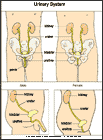
Urethritis with Vulvitis
(Caused by Soap)
What are urethritis and vulvitis?
Urethritis is when the opening of the urethra (tube where the urine comes out) is irritated. When this happens, the area outside the vagina (vulva) is usually irritated as well (vulvitis). This problem almost always occurs before puberty.
The symptoms can include:
- Discomfort, stinging, or burning when urinating.
- Feeling an urgent and frequent need to urinate.
- Itching and pain in the genital area.
What is the cause?
Irritation by chemicals in bubble bath, shampoo, or soap that was left on the genital area is almost always the cause before a child reaches puberty.
5% of young girls do get urinary tract infections (UTI), which can cause the same symptoms. A UTI is a bacterial infection of the bladder (cystitis) and sometimes the kidneys. UTIs must be treated by your health care provider.
For more information see:
How long does it last?
With treatment, the pain and burning usually go away in 12 to 24 hours.
How can I take care of my child?
- Warm baking soda/water soaks
Have your daughter soak her bottom in a basin or bathtub of warm water for 20 minutes. Put 4 tablespoons of baking soda in the water. Be sure she spreads her legs and allows the water to cleanse the genital area. No soap should be used. Repeat this every 4 hours while she is awake. These soaks will remove any soap, concentrated urine, or other irritants from the genital area. With soaks, the burning will usually clear in 12 to 24 hours. Thereafter, cleanse the genital area once a day with warm water.
- Instructions for collecting a midstream, clean-catch
urine specimen at home
If you are told to bring in a urine sample, try to collect the first one in the morning. Use a sterile jar.
Wash off the genital area several times with cotton balls and warm water. Have your child then sit on the toilet seat with her legs spread widely so that the skin folds of the vagina don't touch. Have her start to urinate into the toilet, and then place the clean container directly in line with the urine stream. Remove it after you have collected a few ounces but before she stops urinating. The first or last ounce that comes out of the bladder may be contaminated.
Keep the urine in the refrigerator until you take it to the office. Keep it cool when you bring it to the office by placing it in a cooler or a plastic bag with some ice.
How can I help prevent this problem?
- Wash the genital area with water, not soap.
- Don't use bubble bath before puberty. Don't put any other soaps or shampoo into the bath water. Don't let a bar of soap float around in the bathtub. If you are going to shampoo your child's hair, do this at the end of the bath.
- Keep bath time less than 15 minutes. Have your child urinate immediately after baths.
- Teach your daughter to wipe herself correctly from front to back, especially after a bowel movement.
- Encourage her to drink enough fluids each day to keep the urine light colored.
- Encourage her to urinate at least every 4 hours during the day.
- Have her wear cotton underpants. Underpants made of synthetic fibers (polyester or nylon) don't allow the skin to "breathe." Discourage wearing underpants during the night.
When should I call my child's health care provider?
Call IMMEDIATELY if:
- The pain with urination becomes severe.
- Your child also has abdominal or back pain.
- Your child starts acting very sick.
Call during office hours if:
- The pain continues more than 24 hours after warm water/baking soda soaks.
- Your child develops a fever.
- You have other questions or concerns.

